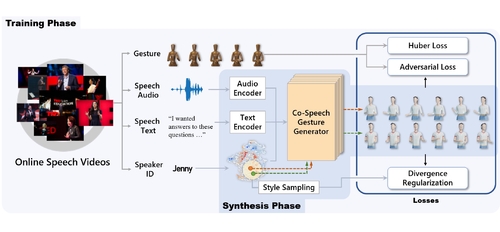Pre-recorded Sessions: From 4 December 2020 | Live Sessions: 10 – 13 December 2020
4 – 13 December 2020
Pre-recorded Sessions: From 4 December 2020 | Live Sessions: 10 – 13 December 2020
4 – 13 December 2020
#SIGGRAPHAsia | #SIGGRAPHAsia2020
#SIGGRAPHAsia | #SIGGRAPHAsia2020











Date/Time:
04 – 13 December 2020
All presentations are available in the virtual platform on-demand.
Lecturer(s):
Youngwoo Yoon, Electronics and Telecommunications Research Institute (ETRI), Korea Advanced Institute of Science and Technology (KAIST), South Korea
Bok Cha, University of Science and Technology, Electronics and Telecommunications Research Institute (ETRI), South Korea
Joo-Haeng Lee, Electronics and Telecommunications Research Institute (ETRI), University of Science and Technology, South Korea
Minsu Jang, Electronics and Telecommunications Research Institute (ETRI), South Korea
Jaeyeon Lee, Electronics and Telecommunications Research Institute (ETRI), South Korea
Jaehong Kim, Electronics and Telecommunications Research Institute (ETRI), South Korea
Geehyuk Lee, Korea Advanced Institute of Science and Technology (KAIST), South Korea
Bio:
Description: For human-like agents, including virtual avatars and social robots, making proper gestures while speaking is crucial in human--agent interaction. Co-speech gestures enhance interaction experiences and make the agents look alive. However, it is difficult to generate human-like gestures due to the lack of understanding of how people gesture. Data-driven approaches attempt to learn gesticulation skills from human demonstrations, but the ambiguous and individual nature of gestures hinders learning. In this paper, we present an automatic gesture generation model that uses the multimodal context of speech text, audio, and speaker identity to reliably generate gestures. By incorporating a multimodal context and an adversarial training scheme, the proposed model outputs gestures that are human-like and that match with speech content and rhythm. We also introduce a new quantitative evaluation metric for gesture generation models. Experiments with the introduced metric and subjective human evaluation showed that the proposed gesture generation model is better than existing end-to-end generation models. We further confirm that our model is able to work with synthesized audio in a scenario where contexts are constrained, and show that different gesture styles can be generated for the same speech by specifying different speaker identities in the style embedding space that is learned from videos of various speakers. All the code and data is available at https://github.com/ai4r/Gesture-Generation-from-Trimodal-Context.
